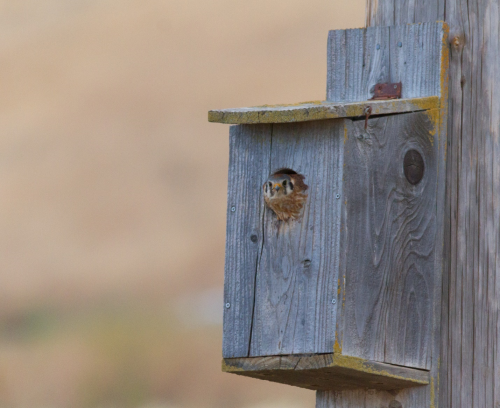eOrganic authors:
Olivia Smith, University of Georgia
Ryan Bourbour, University of California Davis
Kevin A. Cornell, Washington State University
Sarah Groendyk, Michigan State University
Melissa Hannay, Michigan State University
Breanna Martinico, University of California Davis
Olivia Utley, Michigan State University
William Snyder, University of Georgia
Catherine Lindell, Michigan State University
Introduction
Birds of prey, commonly called raptors, are valued by many growers for cultural and aesthetic reasons, in addition to the beneficial pest control services they provide (Kross et al., 2017).
Raptors are often difficult to distinguish from each other aside from a few raptors with telltale markings, such as the distinct red tail of the red-tailed hawk (Buteo jamaicensis) or the white head of a bald eagle (Haliaeetus leucocephalus). Habitat can also be a good cue because some raptors are strongly associated with grassland habitat, while others are associated with forests, urban areas, or agriculture. These habitat associations and each raptor’s distinct nesting needs mean that different approaches are needed to attract different raptor species. Further, the land usage of your neighbors can affect which raptor species are likely to visit your farm. Here, we provide information about how to identify and manage six raptor species commonly found on farms in the United States. We also provide information on what types of pests each can help control and highlight how pest control services may scale up to increased farm profitability (Kross et al., 2012; Shave et al., 2018). For example, Kross et al. (2012) showed that reintroduction of threatened falcons into vineyards could increase Pinot Noir profitability by $326/ha. We conclude by providing additional resources to continue learning about raptors.
Conservation of raptors on farms is a timely and pressing matter: a recent study found that we have lost 3 billion birds in North America alone since 1970 (Rosenberg et al., 2019). Habitat loss and environmental contamination are often major drivers of declines. Raptors are particularly sensitive to use of rodenticides used in urban and agricultural settings, which can cause death through secondary poisoning (Murray, 2007; Hindmarch et al., 2017). Among the most vulnerable birds to habitat loss are grassland species, such as the northern harrier (Circus hudsonius), for which agricultural intensification is a leading cause of decline (Rosenberg et al., 2019). Creating raptor-friendly farmlands can help conserve these culturally and ecologically important birds that provide non-toxic, natural pest control services for farmers.
American Kestrel (Falco sparverius)
Identification
American kestrels (Falco sparverius), hereafter kestrels, are North America's smallest and most common falcon, often seen perched on wires by the side of the road or hovering over open fields while hunting for small rodents, birds, or insects (Smallwood and Bird, 2002). They have long, pointed wings; a relatively long, rounded tail; and short, yellow legs and toes with black talons (Fig. 1). As is the case for many raptors, kestrels are a sexually dimorphic species, which means that males and females do not look the same. Females are larger and less colorful than males. Males have blue-gray wings with black primary feathers, a reddish-brown back with black barring, an unbarred reddish-brown tail with a white tip and thick black band on the tip of the tail, and a pale cream to yellowish breast with variable amounts of black spotting. The wings, back, and tail of females are reddish-brown with black barring, and the breast is yellowish with vertical reddish-brown streaking. Both sexes have a blue-gray top of the head with a reddish-brown center, a white throat, white cheeks with two vertical black facial stripes, and two black spots near the back of the neck that resemble eye spots. The head is relatively large and square with large eyes, a prominent ridge above the eyes, and a small curved bill. Their vocalization is a shrill klee klee klee klee.
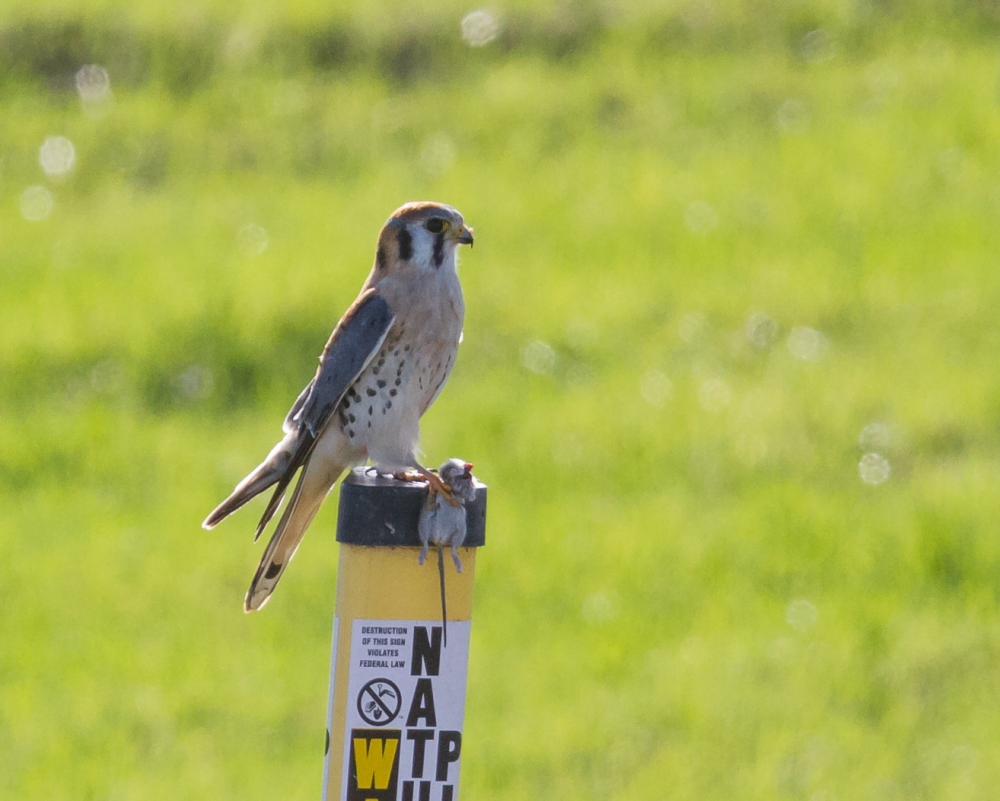
Figure 1. Male American kestrel with rodent prey. Note the two vertical, black facial stripes often called handlebar mustaches by birders. Male kestrels have slate-colored wings, rufous backs with black barring, and unbarred rufous tails with a thick black band and white tip. Photo credit: Ryan Bourbour.
Pest Control Services
Predators, including kestrels, can help control pests in the most obvious way—for example, by killing and eating rodents. Interestingly, their very presence can also scare away pest birds or make pest species less active (Cresswell, 2008; Lindell et al., 2018). Kestrels consume a variety of organisms including grasshoppers, worms, songbirds and other perching birds, mammals, and even the occasional reptile (Collopy and Koplin, 1983; Bohall-Wood and Collopy, 1987; Shave, 2017). They have relatively small home ranges (the area that an animal lives in) that center around their nest during the breeding season. Their tendency to use a small space around their nests may concentrate their activity within and around crops if nest boxes are placed in the center of fields (Miller and Smallwood, 1997; Smallwood and Bird, 2002). Kestrels have been demonstrated to improve crop yields, providing a direct economic benefit for growers. For example, kestrels significantly reduced the number of fruit-eating birds in cherry orchards in one Michigan study (Shave et al., 2018). Economic analyses showed that the reduction of fruit-eating birds in cherry crops by kestrels could provide an additional $2.4 million to the Michigan economy alone over a five-year period (Shave et al., 2018).
Management
Kestrels have been declining for decades. According to the North American Breeding Bird Survey, there was a 1.4% range-wide decline from 1966 to 2015 (Sauer et al., 2017). This drop in kestrel numbers was especially severe in the New England/Mid-Atlantic Coast region, where the decline for that same period was 5.3% (Sauer et al., 2017). There are several hypotheses as to the cause of this decline, including pesticides (Rattner et al., 2015), loss of habitat (Farmer et al., 2008), and climate change (Steenhof and Peterson, 2009). However, research has not identified a single culprit behind kestrel declines, which is a great cause of concern for the future of the species, and requires further research (McClure et al., 2017).
Kestrels can be attracted to farms and fields using nest boxes and are tolerant of human activity (Fig. 2; Shave and Lindell, 2017a). Kestrels are secondary cavity nesters, meaning that they depend on other species to carve out cavities for them to use. They will nest in both natural cavities in trees and in man-made structures, such as barns and nest boxes (Smallwood and Bird, 2002). Installing nest boxes has been shown to increase the number of kestrels in an area (Smallwood and Collopy, 2009; Shave and Lindell, 2017b); however, it may take several years for kestrels to find and use new nest boxes. To maximize the odds that kestrels will successfully nest in an artificial nest box, it must be constructed to certain specifications (see http://www.nestboxbuilder.com/nestbox-article-spartan.html and https://nestwatch.org/learn/all-about-birdhouses/birds/american-kestrel/ for details). Nonnative pest species such as European starlings (Sturnus vulgaris) will often nest in kestrel nest boxes (McClure et al., 2015). Information on deterring starlings from nest boxes can be found here.
Figure 2. American kestrel peering out of nest box. Installation of nest boxes near or within crops can help harness the pest control services of these falcons. Nest box plans for kestrels can be downloaded at https://nestwatch.org/learn/all-about-birdhouses/birds/american-kestrel/. Photo credit: Ryan Bourbour.
Cooper's Hawk (Accipiter cooperii)
Identification
Cooper's hawks (Accipiter cooperii) are medium-sized hawks that are found throughout North America. They are approximately crow-sized with yellow legs (Fig. 3). As is the case with other raptors, juveniles and adults differ in plumage: juveniles are mostly brown on the back and off-white with brown stripes on the underside, whereas adults have blue-brown to blue-gray feathers on the back and barred reddish-brown underparts (Fig. 3). Adults also have red eyes whereas juveniles have yellow eyes. Their wings are rounded, and their tails are relatively long, which both assist in the species’ remarkable speed and maneuverability when in pursuit of prey in thick forests. Similar species include the smaller sharp-shinned hawk (A. striatus) and larger northern goshawk (A. gentilis). Compare the Cooper’s hawk with these similar species here. When field visuals are limited (e.g., dense wooded areas), vocalizations can be used to identify hawks. Males and females frequently communicate, particularly in wooded areas, and occasionally in urban areas where they are now being found at higher rates (Rosenfield, 2018). Food and alarm calls are a standalone whaaa or continuous series of pek-pek-pek.
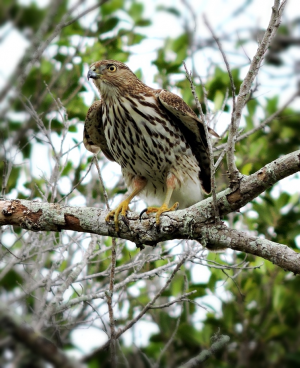

Figure 3. Juvenile (left) and adult (right) Cooper's hawks. Note the yellow legs and small, hooked bill on both. Cooper’s hawks have streaked tails. Juvenile: brown upper parts and white/brown streaked underparts with a yellow eye. Adult: bluish-gray upper parts, black cap, red eye, and reddish-barred underparts. Photo credit: Left: Amber Dawn, Cooper’s Hawk, Pixabay license; Right: This is for the birds, Cooper’s hawk, CC BY-NC-ND 2.0.
Pest Control Services
Prey primarily consists of small, ground-dwelling birds (e.g., songbirds and pigeons), with small mammals being secondarily important (e.g., rabbits, mice, and ground squirrels; Bosakowski et al., 1992; Rosenfield, 2018). Twelve studies conducted throughout North America found that birds comprised anywhere from 56% to 96% of Cooper’s hawk diets, with variation by region. For example, small mammals were a larger portion of Cooper’s hawks’ diets in Midwestern and Western states compared to other regions (Rosenfield, 2018). Cooper’s hawks are known to prey heavily on several bird species considered to be large agricultural pests including house sparrows (Passer domesticus), American robins (Turdus migratorius), and European starlings (Bielefeldt et al., 1992). However, no bird is safe from the adept Cooper’s hawk. Birds known to benefit agriculture (e.g., kestrels [see above]), species of concern (e.g., burrowing owls [Athene cunicularia]), and poultry are commonly preyed upon by the Cooper’s hawk (Rosenfield, 1988).
Management
Cooper’s hawks commonly nest in suburban and urban landscapes and are frequently cited as the most common backyard breeding raptor (Rosenfield et al., 2019). They will fly close to the ground while in pursuit of prey, using bushes and buildings to conceal their approaches (Rosenfield, 2018). With a history of persecution, the Cooper's hawk has been labeled as the chicken hawk and a villain bird. They were heavily hunted and subsequently wiped out from expanding developed areas during the early 20th century (Bent, 1937). More recently, populations have grown and stabilized but remain sensitive to human disturbances at nesting sites (Bielfeldt, 1992). Maintenance of tree stands and groves, while minimizing disturbances during the breeding season, will help promote thriving populations of Cooper’s hawks (Boal and Mannan, 1998). However, due to their broad diet and taste for domestic poultry, promotion of this bird could be problematic, especially for farms with chickens. Overhead fencing could help protect poultry from avian predators. Cooper’s hawks may also deter beneficial kestrels and barn owls (Tyto alba) from establishing residency in nesting boxes. The Cooper’s hawk’s net impact on crop production has yet to be explored in detail but likely will be a mix of benefits and harms.
Red-tailed Hawk (Buteo jamaicensis)
Identification
Red-tailed hawks are commonly found across North America and can be highly variable in coloration. They are often observed along roadways, perched on power poles, or soaring through the air. They are relatively large, brown hawks and can range from having a white chest with varying degrees of brown streaking to having a solid brown chest. In the Western United States, these hawks will most commonly have an off-white chest with brown streaky markings creating a belly band (Preston and Beane, 2009). Their trademark identification feature is the red tail (Fig. 4); however, this may be difficult to see on far away or high-flying birds. In the first year of life, individuals have brown-banded tails that do not get replaced with red tail feathers until their second year (Fig. 5; Preston and Beane, 2009). While soaring, these hawks can be distinguished from other hawks by the dark leading edge on their wing, also known as patagial markings (Preston and Beane, 2009). Adult red-tailed hawks make a screaming kee-eeeee-arr, which interestingly, is used in films alongside shots of bald eagles. Bald eagles make a much less intimidating, weak, high-pitched series of whistles despite their larger size.
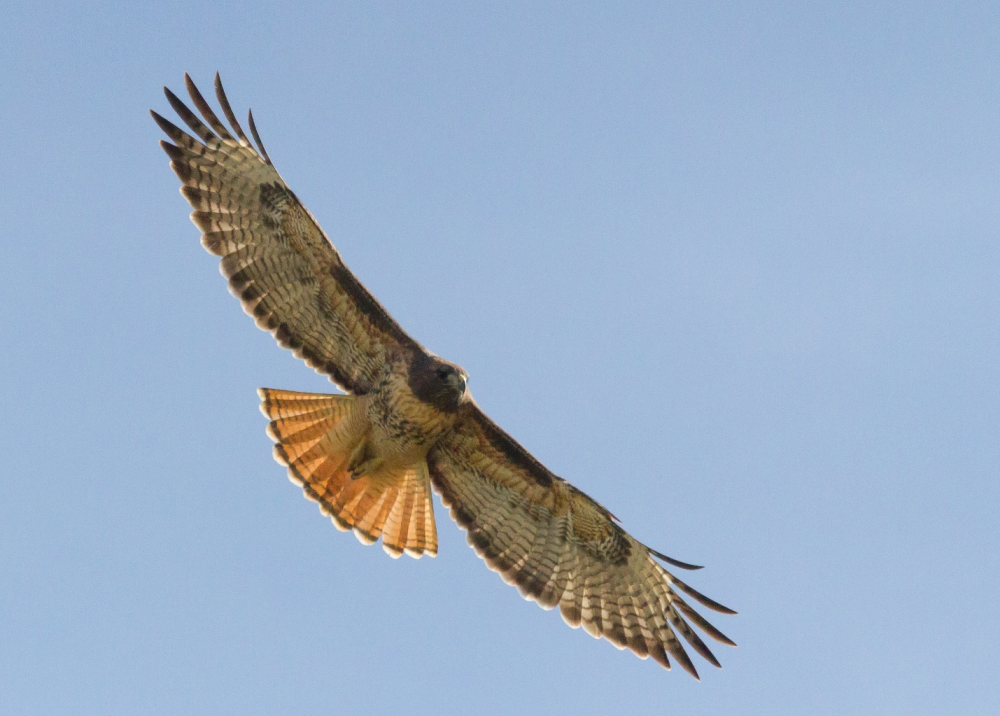
Figure 4. Adult western light morph red-tailed hawk in flight displaying characteristic dark patagial markings on the leading edge of the wings, dark belly band, and red tail. Photo credit: Ryan Bourbour.
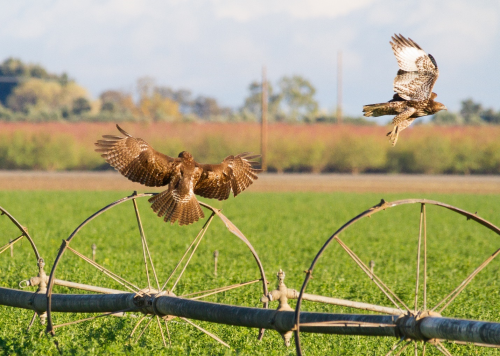
Figure 5. Juvenile red-tailed hawks utilizing farm equipment to perch while hunting in an alfalfa field. Note the streakier overall underside on these juveniles compared to adults and their brown-banded, rather than red, tail. Photo credit: Ryan Bourbour.
Pest Control Services
Red-tailed hawks are opportunistic hunters that consume small- to medium-sized mammals, including many rodents that are considered great pests in agriculture, such as ground squirrels, mice, rats, gophers, and voles. In addition, they will consume jackrabbits, cottontail rabbits, and tree squirrels. They less commonly prey upon reptiles, such as snakes, and medium-sized birds, such as pigeons, pheasants, and ducks (Preston and Beane, 2009). Red-tailed hawks’ diets will largely depend on what is available and abundant, and may differ greatly between regions and seasons. Although red-tailed hawks consume pest rodents as a large portion of their diets and their presence is thought to reduce pest activity, few empirical studies have quantified the value and magnitude of the pest-control services this species can provide.
Management
Red-tailed hawks build sturdy stick nests in large trees or man-made structures, such as transmission towers (Preston and Beane, 2009). Planting and preserving large trees within farming areas that are stand-alone, part of a hedgerow, or in a riparian area will help facilitate red-tailed hawk presence and nesting. While hunting, red-tailed hawks will soar or perch on trees or structures to survey the landscape for prey. In agricultural settings, hunting may be facilitated by the installation of artificial perches that are roughly 15’ high with a wooden crossbeam. Wong and Kross (2018) found that raptor perches placed in locations along hilltops or flat ground with a good view of the surrounding area were used more often than perches near trees or at hill bottoms. Because red-tailed hawks commonly consume rodent pests that are targeted with anticoagulant rodenticides, they can be susceptible to secondary rodenticide poisoning through consuming poisoned prey (Loredo-Prendeville et al., 1994). Wide-scale use of anticoagulant rodenticides in agricultural areas with high red-tailed hawk or other raptor activity is a leading threat to conservation. Many research groups and raptor conservation organizations have additional information on impacts of rodenticides and other pesticides and how to naturally control rodents (e.g., here, here, and here).
Northern Harrier
Identification
Northern harriers (also called marsh hawks) are medium-sized raptors with long, broad wings held in a “V” while flying, and a long tail separated from the body by a telltale white stripe at the base (Fig. 6). Looking for the white stripe at the base of the tail is the quickest way to distinguish the northern harrier from other raptors. Adult females have a dark-brown head and wings and are pale on their underparts with white and brown streaking. Adult males have light-grayish wings with dark trailing wing-edges and are sometimes referred to as gray ghosts. Northern harriers have face shapes more like owls than other hawks which, like owls, helps them hear and locate rodent prey. The northern harrier often flies low to the ground over grasslands, fields, and wetlands (their primary habitats) with intermittent flapping and a wobbly trajectory. Harrier calls consist of a fast series of 1-2 second kek notes. As a note on taxonomy, some debate exists if C. hudsonius is truly a separate species from the European hen harrier, C. cyaneus, and some authorities still consider the North American northern harrier as C. cyaneus (Etherington & Mobley, 2016).

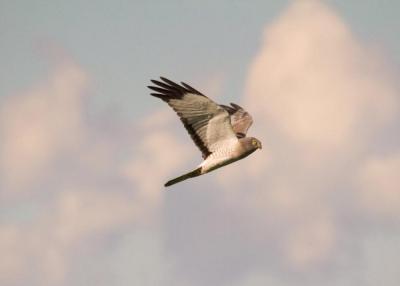
Figure 6. Northern harrier female (left) and male (right). Females have brown and white streaked underparts, while males are mostly whiteish below with slate-gray coloration on the breast and upper parts. Harriers are most quickly identified by the white rump patch visible on the photo to the right. Photo credit: Ryan Bourbour
Pest Control Services
The northern harrier’s summer diet consists of small- to medium-sized mammals (mostly rodents), birds (mostly songbirds and small waterbirds), reptiles, and frogs (Smith et al., 2011). Similar to other raptors, their diets are variable by region, habitat, and season. A study conducted in New Brunswick in a predominately agricultural area found that Microtus voles comprised 70.4% of the northern harrier diet, with passerines (perching birds including songbirds and flycatchers), primarily bobolinks (Dolichonyx oryzivorus), comprising the second largest portion at 20.9% (Barnard et al., 1987). Microtus voles have been reported to comprise from 2.5–59.7% of northern harrier breeding season diets in other regions (Errington, 1933; Errington and Beckenridge, 1936; Hecht, 1951; Selleck and Glading, 1943). Conversely, ground squirrels formed the highest portion of harrier diets in an agricultural area of Iowa (38.8%) and across habitat types in Wisconsin (35.7%; Errington, 1933; Errington and Beckenridge, 1936). A study conducted at Dune Lakes, California found that red-winged blackbirds (Agelaius phoeniceus) and yellow-headed blackbirds (Xanthocephalus xanthocephalus), species often considered pests by farmers, formed the largest portion of harrier diets (22.8%; Selleck and Glading, 1943). Few scientific studies have tried to link the northern harriers’ heavy rodent consumption to in-field pest control services, leaving uncertainty around their exact benefit.
Management
Northern harriers are listed as Endangered or as Species of Special Concern in many states, largely due to loss of wetlands and grassland habitats converted to agriculture, although secondary poisoning from pesticides, rodenticides, lead, and illegal shooting are secondary reasons of decline (Duebbert and Lokemoen, 1977; Toland, 1985; Lima and Salmon 2010; Mineau and Whiteside, 2013; Smith et al., 2011). In addition to full conversion of native grassland to crops or pastures, early mowing of grasslands and pastures can destroy nests and decrease prey densities necessary to feed young (Duebbert and Lokemoen 1977, Smith et al., 2011). Further, grazing livestock can lower the suitability of grasslands for harrier nesting and can destroy eggs through trampling (Fondell and Ball, 2004; Rolek et al., 2016). Human monitoring of nests can also cause abandonment, particularly before eggs hatch, so monitoring nests closely is not recommended (Smith et al., 2011). Promotion of grassland habitat, including through the Conservation Reserve Enhancement Program, can help promote northern harriers, red-tailed hawks, and kestrels (Wilson et al., 2010).
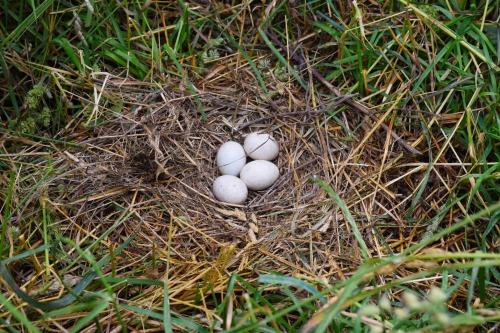
Figure 7. Northern harrier nest with 4 eggs constructed in a sheep pasture on an organic farm near Portland, Oregon. Northern harriers are ground nesting birds, which makes them susceptible to egg predation and nesting failure. Photo credit: Olivia Smith.
Barn Owl (Tyto alba)
Identification
Barn owls are a medium-sized owl found nearly worldwide (Taylor, 2004). Barn owls have cinnamon coloration on the back of their heads and wings (Fig. 8). They have white chests and white on the undersides of their wings. They are most often observed in flight at night, and the low lighting conditions make them appear pure white (Marti et al., 2005). Additionally, they have rounded heads with a white heart-shaped face and large dark eyes, which are all features that allow barn owls to be efficient hunters in almost pitch-black conditions (Fig. 9; Marti et al., 2005). Because barn owls hunt while flying low over the ground, they are most commonly associated with open habitats, such as grasslands or open agricultural areas. Similar to other owl species, barn owl feathers are very soft, which enables them to fly nearly silently and go undetected by their prey. Most famously, barn owls are known for their loud, harsh screech-like call, often given in flight; however, if you are near breeding barn owls, you may also hear cricket-like chirps coming from courting adults or from adults bringing food back to a nest (Marti et al., 2005).
Figure 8. Barn owl in flight displaying white underparts. Photo credit: Ryan Bourbour.

Figure 9. Barn owl roosting in a hedgerow along a field edge. Note the characteristic heart-shaped facial disk. Photo credit: Ryan Bourbour.
Pest Control Services
Barn owls are considered a farmer’s best friend because they mainly hunt nocturnal rodents that are considered agricultural pests including mice, voles, gophers, and rats. Other less common prey include rabbits, small birds, beetles, and grasshoppers. In the Central Valley of California, a study of barn owl diets on farms found that over 99% of their diet consisted of pest rodents (Kross et al., 2016). Kross and Baldwin (2016) estimated that a single nesting pair and their progeny consume 98 kg of prey per year. Another study in California found that the presence of barn owls greatly reduced gopher activity (Browning et al., 2016), similar to the impacts of kestrels on birds mentioned above. Barn owls nesting on farms are known to hunt in crop fields but often prefer hunting on field edges or in adjacent natural open habitats (Castañeda, 2018). Barn owl hunting along field edges or in habitats adjacent to fields can still be beneficial for farming operations because pest rodents can move between natural habitats and fields. Studies have shown that the rodent control services provided by barn owls can scale up to increase farm profitability (Motro, 2011). For example, Motro (2011) showed that barn owl presence increased alfalfa yield by 3.24% with a corresponding profit of $30/ha, after accounting for the nest box cost.
Management
Barn owls are a cavity-nesting species that historically found nest sites in tree cavities or old barns. With the intensification of agriculture and subsequent habitat loss, absence of these nest locations has limited barn owl breeding (Taylor, 2004; Marti et al., 2005). Farmers can increase barn owl presence on their properties by installing artificial nest boxes (Fig. 10). However, the amount of time it takes for barn owls to become established in a new nest box depends on the proximity to existing and nearby barn owl populations. Since breeding barn owls are less territorial than most raptors, nest boxes can be installed at a relatively high density, i.e., 50-100 meters apart (Kross et al., 2016). Box designs specifically for barn owls should consider protection from predators (installed on poles rather than in trees, appropriately sized openings with talon grooves, no perches on the front of the box), heat stress (proper ventilation, sunshades, openings facing towards the north or east in warmer climates, and white paint in warmer climates), and easy access for annual cleaning (pellet debris from previous nests should be cleaned out and replaced with a layer of fresh sawdust in late fall/early winter; Wendt and Johnson, 2017). Great horned owls (Bubo virginianus) are a common predator of barn owls and can greatly reduce survival of fledglings. Therefore, placing barn owl boxes near heavily wooded areas or in areas with a large great horned owl population should be avoided (Marti et al., 2005).

Figure 10. Example of good barn owl nest box installed in an orchard. Photo credit: Ryan Bourbour.
Great Horned Owl (Bubo virginianus)
Identification
Great horned owls occur in a variety of habitats throughout North and South America (Fig. 11). Great horned owls exhibit a strong preference for open woodlands, orchards, and agriculture (Artuso et al., 2013). They are large (1.5–2 feet long) and heavy for birds (910–2500 g) with erect ear-tufts and yellow eyes. Their plumage is dark with a mix of blacks, browns, and grays; and great horned owls have a conspicuous white throat and bib around the upper chest (Fig. 11). Their facial disc is brown to orange and well-defined. Male and female great horned owls can often be heard engaging in alternating hooting at night consisting of a soft, stuttering rhythm hoo-h’HOO-hoo-hoo, reminiscent of owl soundtracks in Halloween films. Young owls make a piercing screech to beg for food, while adults screech to defend the nest.

Figure 11. Adult male great horned owl. Note the white bib on the chest (which may not always be conspicuous), orange facial disc, and tufted ears. Photo credit: Wayne Linton, Great Horned Owl, Pixabay license.
Pest Control Services
Great horned owls are nocturnal, opportunistic predators that eat a variety of mammals, birds, fish, reptiles, amphibians, and insects. While their diets will vary among locations and regions, approximately 90% of their total consumed biomass consists of small mammals, such as voles (Microtus spp.) and deer mice (Peromyscus spp.; Cromrich et al., 2002). For example, in Montana, voles accounted for 93% of the total annual diet (Cromrich et al., 2002), which is remarkably high. In Oklahoma, cotton rats comprised 66% of the winter diet (Tyler and Jensen, 1981), while opossums were the greatest component (33% of total diet) in Pennsylvania (Wink et al., 1987). Waterfowl have also been identified as a potentially important spring food source for great horned owls (Rohner et al., 2001). For example, in North Dakota, the total biomass of coots and rails consumed by great horned owls was double the biomass of mammals consumed (Murphy, 1997). Great horned owls will target poultry as a food source on rare occasions during the spring breeding season (2 out of 2500+ prey items were poultry in Artuso et al., 2013). However, a hungry juvenile may return to a poultry coop more frequently in the fall (Artuso et al., 2013).
Because of the great horned owl’s remarkable hunting capabilities and dietary flexibility, they may provide significant rodent reduction services to agricultural fields. However, no research has been conducted on the long-term vermin control efficacy of great horned owls in an agricultural setting, so the extent of their economic benefit to farmers is not yet known. Additionally, as mentioned above, great horned owls are aggressive towards barn owls and other raptors, often removing them from nesting cavities and occasionally even preying upon them (Knight and Jackman, 1984). Promoting both species may come with tradeoffs.
Management
Despite large declines of many North American breeding birds over recent decades (Rosenberg et al., 2019), great horned owls have largely maintained robust populations due to their ability to adapt to suburban and disturbed landscapes (Root, 1988). However, even urban populations have been declining recently with increasing human population densities. Great horned owls hunt from perches adjacent to open areas, including in tall trees and shrubs, bridges, telephone poles, fence posts, barns, houses, and other buildings (Peterson, 1979). Nesting sites are typically large, open stick nests created by other species, e.g., red-tailed hawks and common ravens (Corvus corax) on any tree, but they will also use nesting cavities in trees and structures (Baumgartner, 1938). Artificial nest sites can encourage breeding owls to take residency. Great horned owls frequently live in agricultural areas due to the abundance of prey found there. Occasionally, great horned owls are removed or discouraged by conservationists to prevent predation of endangered species or other owls (Artuso et al., 2013). As with other raptors, secondary poisoning from pesticides and rodenticides can cause direct mortality or changes in behavior that lead to mortality, which have, unfortunately, been commonly documented (Mendenhall and Pank, 1980; Blus, 1996).
Additional Resources
The Cornell Lab of Ornithology has a great citizen scientist network with detailed information on nest construction and placement (nestwatch.org), recommendations on attracting species of interest (content.yardmap.org/learn/), and range information (ebird.org). The lab offers several opportunities to get involved with scientific data collection through Project FeederWatch (feederwatch.org), eBird (eBird.org), and NestWatch (nestwatch.org). Basic species information can be found at allaboutbirds.org, and the Merlin Bird ID app can aid in field identification. The National Audubon society also provides species accounts with identification information (https://www.audubon.org). Wild Farm Alliance has information on managing beneficial birds on farms, including raptors (wildfarmalliance.org/birds).
References and Citations
- Artuso, C., C. S. Houston, D. G. Smith, and C. Rohner. 2013. Great horned owl (Bubo virginianus). In A. F. Poole (ed.) The Birds of North America. Cornell Lab of Ornithology, Ithaca, NY. USA. (Available online at: https://birdsna.org/Species-Account/bna/species/grhowl) (verified 22 February 2020).
- Barnard, P., B. MacWhirter, R. Simmons, G. L. Hansen, and P. C. Smith. 1987. Timing of breeding and the seasonal importance of passerine prey to northern harriers (Circus cyaneus). Canadian Journal of Zoology 65:1942—1949. (Available online at: https://doi.org/10.1139/z87-295) (verified 4 March 2020).
- Baumgartner, F. M. 1938. Courtship and nesting of the great horned owls. Wilson Bulletin 50:274—285. (Available online at: https://www.jstor.org/stable/4156775) (verified 4 March 2020).
- Bent, A. C. 1937. Life histories of North American birds of prey, part 1, order Falconiformes. United States National Museum Bulletin 167. United States Government Printing Office, Washington, D.C. (Available online at: https://doi.org/10.5479/si.03629236.167.i) (verified 15 Oct 2020).
- Bielefeldt, J., R. N. Rosenfield, and J. M. Papp. 1992. Unfounded assumptions about diet of the Cooper's hawk. Condor 94:427—436. (Available online at: https://doi.org/10.2307/1369215) (verified 4 March 2020).
- Blus, L. J. 1996. Effects of pesticides on owls in North America. Journal of Raptor Research 30:198—206. (Available online at: https://pubs.er.usgs.gov/publication/1015661) (verified 4 March 2020).
- Boal, C. W., and R. W. Mannan. 1998. Nest site selection by Cooper's hawks in an urban environment. Journal of Wildlife Management 62:864—871. (Available online at: https://www.jstor.org/stable/3802537) (verified 4 March 2020).
- Bohall-Wood, P. G. and M. W. Collopy. 1987. Foraging behavior of southeastern American kestrels in relation to habitat use. InD. M. Bird and R. Bowman (eds.) The Ancestral Kestrel. Allen Press, Inc. Lawrence, KS.
- Bosakowski, T., D. G. Smith, and R. Speiser. 1992. Nest sites and habitat selected by Cooper's hawks, Accipiter cooperii, in northern New Jersey and southeastern New York. Canadian Field-Naturalist 106:474—479.
- Castañeda, X. A. 2018. Hunting habitat use and selection patterns of barn owl (Tyto alba) in the urban-agricultural setting of a prominent wine grape growing region of California. MS Thesis, Humboldt State University, Arcata, CA, USA. (Available online at: https://digitalcommons.humboldt.edu/etd/177) (verified 20 March 2020).
- Collopy, M. W., and J. R. Koplin. 1983. Diet, capture success, and mode of hunting by female American Kestrels in winter. The Condor 85:369—371. (Available online at: https://www.jstor.org/stable/1367081) (verified 4 March 2020).
- Cresswell, W. 2008. Non‐lethal effects of predation in birds. Ibis 1:3—17. (Available online at: https://doi.org/10.1111/j.1474-919X.2007.00793.x) (verified 4 March 2020).
- Duebbert, H. F., and J. T. Lokemoen. 1977. Upland nesting of American bitterns, marsh hawks, and short-eared owls. The Prairie Naturalist 9:33—40. (Available online at: https://digitalcommons.unl.edu/usfwspubs/248/) (verified 5 March 2020).
- Errington, P. L. 1933. Food habits of Southern Wisconsin raptors. Part II. Hawks. The Condor 35:19—29. (Available online at: https://www.jstor.org/stable/1363461) (verified 4 March 2020).
- Errington, P. L., and W. J. Breckenridge. 1936. Food habits of marsh hawks in the glaciated prairie region of North-Central United States. The American Midland Naturalist 17:831—848. (Available online at: https://www.jstor.org/stable/2420690) (verified 4 March 2020).
- Etherington, G. J., and J. A. Mobley. 2016. Molecular phylogeny, morphology and life-history comparisons within Circus cyaneus reveal the presence of two distinct evolutionary lineages. Avian Research 7:17. (Available online at: https://avianres.biomedcentral.com/articles/10.1186/s40657-016-0052-3) (verified 4 March 2020).
- Farmer, C. J., L. J. Goodrich, E. R. Inzunza, and J. P. Smith. 2008. Conservation status of North America's birds of prey. State of North America's birds of prey. Series in Ornithology 3:303—420. (Available online at: http://rpi-project.org/publications/TP-07.pdf) (verified 4 March 2020).
- Fondell, T. F., and I. J. Ball. 2004. Density and success of bird nests relative to grazing on Western Montana grasslands. Biological Conservation 117:203—213. (Available online at: https://doi.org/10.1016/S0006-3207(03)00293-3) (verified 5 March 2020).
- Hecht, W. R. 1951. Nesting of the marsh hawk at Delta, Manitoba. The Wilson Bulletin 63:197—176. (Available online at: https://www.jstor.org/stable/4157969) (verified 4 March 2020).
- Hindmarch, S., J. E. Elliott, S. Mccann, and P. Levesque. 2017. Habitat use by barn owls across a rural to urban gradient and an assessment of stressors including, habitat loss, rodenticide exposure and road mortality. Landscape and Urban Planning 164:132—143. (Available online at: http://dx.doi.org/10.1016/j.landurbplan.2017.04.003) (verified 4 Oct 2020).
- Knight, R. L. and R. E. Jackman. 1984. Food-niche relationships between great horned owls and common barn-owls in eastern Washington. Auk 101:175—179. (Available online at: https://www.jstor.org/stable/4086243) (verified 4 March 2020).
- Kross, S. M., J. M. Tylianakis, and X. J. Nelson. 2012. Effects of introducing threatened falcons into vineyards on abundance of Passeriformes and bird damage to grapes. Conservation Biology 26:142—149. (Available online at: https://doi.org/10.1111/j.1523-1739.2011.01756.x) (verified 4 Oct 2020).
- Kross, S. M., R. P. Bourbour, and B. L. Martinico. 2016. Agricultural land use, barn owl diet, and vertebrate pest control implications. Agriculture, Ecosystems & Environment 223:167—174. (Available online at: https://doi.org/10.1016/j.agee.2016.03.002) (verified 4 March 2020).
- Kross, S. M., K. P. Ingram, R. F. Long, and M. T. Niles. 2017. Farm perceptions and behaviors related to wildlife and on-farm conservation actions. Conservation Letters 11:e12364. (Available online at: https://doi.org/10.1111/conl.12364) (verified 4 March 2020).
- Lima, L. L., and T. P. Salmon. 2010. Assessing some potential environmental impacts from agricultural anticoagulant uses. Proceedings of the 24th Vertebrate Pest Conference 24:199—203. (Available online at: https://escholarship.org/uc/item/4bt7b8dc) (verified 5 March 2020).
- Lindell, C., R. A. Eaton, P. H. Howard, S. M. Roels, and M. E. Shave. 2018. Enhancing agricultural landscapes to increase crop pest reduction by vertebrates. Agriculture, Ecosystems, and Environment 257:1—11. (Available online at: https://doi.org/10.1016/j.agee.2018.01.028) (verified 4 March 2020).
- Loredo-Prendeville, I., D. Van Vuren, A. J. Kuenzi, and M. L. Morrison. 1994. California ground squirrels at Concord Naval Weapons Station: Alternatives for control and the ecological consequences. Proceedings of the Sixteenth Vertebrate Pest Conference 16:72—77. (Available online at: https://escholarship.org/content/qt1g70h1ng/qt1g70h1ng.pdf) (verified 4 March 2020).
- Marti, C. D., A. F. Poole, and L. R. Bevier. 2005. Barn owl (Tyto alba), version 2.0. In A. F. Poole (ed.) The Birds of North America. Cornell Lab of Ornithology, Ithaca, NY. USA. (Available online at: https://doi.org/10.2173/bna.1) (verified 4 March 2020).
- McClure, C. J. W., D. M. Hilleary, and D. P. Spurling. 2015. American kestrels actively exclude European starlings from using a nest box. Journal of Raptor Research 49:231—233. (Available online at: https://doi.org/10.3356/0892-1016-49.2.231) (verified 20 March 2020).
- McClure, C. J. W, S. E. Schulwitz, R. V. Buskirk, B. P. Pauli, and J. A. Heath. 2017. Commentary: Research recommendations for understanding the decline of American kestrels (Falco sparverius) across much of North America. Journal of Raptor Research 51:455—464. (Available online at: https://doi.org/10.3356/JRR-16-73.1) (verified 4 March 2020).
- Mendenhall, V. M., and L. F. Pank. 1980. Secondary poisoning of owls by anticoagulant rodenticides. Wildlife Society Bulletin 8:311—315. (Available online at: https://www.jstor.org/stable/3781183) (verified 4 March 2020).
- Miller, K. E., and J. A. Smallwood. 1987. Natal dispersal and philopatry of Southeastern American kestrels in Florida. The Wilson Bulletin 2:226—232. (Available online at: https://www.jstor.org/stable/4163805) (verified 4 March 2020).
- Mineau, P., and M. Whiteside. 2013. Pesticide acute toxicity is a better correlate of U.S. grassland bird declines than agricultural intensification. PLoS ONE 8:e57547. (Available online at: https://doi.org/journal.pone.0057457) (verified 4 March 2020).
- Motro, Y. 2011. Economic evaluation of biological rodent control using barn owls Tyto alba in alfalfa. Julius-Kuhn-Archiv 432:79. (Available online at: https:/doi.org/10.5073/jka.2011.432.040) (verified 4 Oct 2020).
- Murphy, R. K. 1997. Prey of nesting red-tailed hawks and great horned owls on Lostwood National Wildlife Refuge, northwestern North Dakota. Blue Jay 55:145—148. (Available online at: https://www.researchgate.net/deref/http%3A%2F%2Fdx.doi.org%2F10.29173%2Fbluejay5500?_sg%5B0%5D=83kcu446d2v6AwrZn-KZgq-fQeCj8TWDLlhHqAN6IHFK2kmY7bLWUk4PRLHVKefI0r56cKsIgwmMTyFyJ1gX-ARetw.kuz1vhVa1KGqLOQV01FuxIRPLaI8TleWX-VUk523e_WxGH4KFkEoeS4ZWutntG9YTAN8SUn7KozhGNXpJG487Q) (verified 15 Oct 2020).
- Murray, M. 2017. Anticoagulant rodenticide exposure and toxicosis in four species of birds of prey in Massachusetts, USA, 2012—2016, in relation to use of rodenticides by pest management professionals. Ecotoxicology 26:1041—1050. (Available online at: https://doi.org/10.1007/s10646-017-1832-1) (verified 4 Oct 2020).
- Petersen, L. 1979. Ecology of great horned owls and red-tailed hawks in southeastern Wisconsin. Wisconsin Department of Natural Resources Technical Bulletin 111, Madison, WI. (Available online at: http://digital.library.wisc.edu/1711.dl/EcoNatRes.DNRBull111) (verified 15 Oct 2020).
- Preston, C. R. and R. D. Beane. 2009. Red-tailed hawk (Buteo jamaicensis), version 2.0. In A. F. Poole (ed.) The Birds of North America. Cornell Lab of Ornithology, Ithaca, NY. (Available online at: https://doi.org/10.2173/bna.52) (verified 4 March 2020).
- Rattner, B. A., K. E. Horak, R. S. Lazarus, S. L. Schultz, S. Knowles, B. G. Abbo, and S. F. Volker. 2015. Toxicity reference values for chlorophacinone and their application for assessing anticoagulant rodenticide risk to raptors. Ecotoxicology 24:720—734. (Available online at: https://link.springer.com/article/10.1007/s10646-015-1418-8) (verified 4 March 2020).
- Rolek, B. W., G. Schrott, D. Z. Poulton, and R. Bowman. 2016. Risk from cattle trampling to nests of an endangered passerine evaluated using artificial nest experiments and simulations. Avian Conservation and Ecology 11:6. (Available online at: http://dx.doi.org/10.5751/ACE-00838-110106) (verified 5 March 2020).
- Root, T. R. 1988. Atlas of wintering North American birds: An analysis of Christmas bird count data. University of Chicago Press, Chicago, IL.
- Rosenberg, K. V., A. M. Dokter, P. J. Blancher, J. R. Sauer, A. C. Smith, P. A. Smith, J. C. Stanton, A. Panjabi, L. Helft, M. Parr, and P. P. Marra. 2019. Decline of the North American avifauna. Science 366:120—124. (Available online at: https://science.sciencemag.org/content/366/6461/120) (verified 4 March 2020).
- Rosenfield, R. N. 1988. Cooper's hawk. In R. S. Palmer, (ed.) Handbook of North American birds, Volume 4, Part 1: Diurnal raptors. Yale University Press, New Haven, CT. pp. 328—330.
- Rosenfield, R. N. 2018. The Cooper’s hawk: Breeding ecology and natural history of a winged huntsman. Hancock House, Blaine, WA.
- Rosenfield, R. N., K. K. Madden, J. Bielefeldt, and O. E. Curtis. 2019. Cooper's hawk (Accipiter cooperii), version 3.0. In A. F. Poole (ed.) The Birds of North America. Cornell Lab of Ornithology, Ithaca, NY. (Available online at: https://doi.org/10.2173/bna.coohaw.03) (verified 25 Feb 2020).
- Sauer, J. R., D. K. Niven, J. E. Hines, D. J. Ziolkowski, Jr, K. L. Pardieck, J. E. Fallon, and W. A. Link. 2017. The North American breeding bird survey, results and analysis 1966—2015. Version 2.07.2017 USGS Patuxent Wildlife Research Center, Laurel, MD. (Available online at: https://www.mbr-pwrc.usgs.gov/bbs/) (verified 4 March 2020).
- Selleck, D. M., and B. Glading. Food habits of nestling barn owls and marsh hawks at Dune Lakes, California as determined by the “cage nest” method. California Fish and Game 29:122—131.
- Shave, M. E. 2017. Evaluating the conservation and agricultural applications of orchard nest boxes for a declining raptor. PhD Dissertation. Michigan State University, Lansing, MI, USA. (Available online at: https://pdfs.semanticscholar.org/6173/988e3e78df608734489047248752ce8c2f...) (verified 4 March 2020).
- Shave, M. E., and C. A. Lindell. 2017a. American kestrels occupying nest boxes in Michigan cherry orchards show high reproductive rates and tolerance of monitoring. Journal of Raptor Research 51:50—60. (Available online at: https://doi.org/10.3356/JRR-16-43.1) (verified 4 March 2020).
- Shave, M. E., and C. A. Lindell. 2017b. Occupancy modeling reveals territory-level effects of nest boxes on the presence, colonization, and persistence of a declining raptor in a fruit-growing region. PLoS One 12:e0185701. (Available online at: https://doi.org/10.1371/journal.pone.0185701) (verified 4 March 2020).
- Shave, M. E., S. A. Shwiff, J. L. Elser, and C. A. Lindell. 2018. Falcons using orchard nest boxes reduce fruit‐eating bird abundances and provide economic benefits for a fruit‐growing region. Journal of Applied Ecology 55:2451—2460. (Available online at: https://doi.org/10.1111/1365-2664.13172) (verified 4 March 2020).
- Smallwood, J. A. and D. M. Bird. 2002. American kestrel (Falco sparverius), version 2.0. In A. F. Poole and F. B. Gill (eds.) The Birds of North America. Cornell Lab of Ornithology, Ithaca, NY. (Available online at: https://doi.org/10.2173/bna.602) (verified 4 March 2020).
- Smallwood, J. A. and M. W. Collopy. 2009. Southeastern American kestrels respond to an increase in the availability of nest cavities in north-central Florida. Journal of Raptor Research 43:291—300. (Available online at: https://doi.org/10.3356/JRR-08-81.1) (verified 4 March 2020).
- Smith, K. G., S. R. Wittenberg, R. B. Macwhirter, and K. L. Bildstein. 2011. Hen/northern harrier (Circus cyaneus/hudsonius), version 2.0. In A. F. Poole (ed.) The Birds of North America. Cornell Lab of Ornithology, Ithaca, NY. USA. (Available online at: https://birdsna.org/Species-Account/bna/species/norhar) (verified 20 March 2020).
- Steenhof, K. and B. Peterson. 2009. American kestrel reproduction in southwestern Idaho: Annual variation and long-term trends. Journal of Raptor Research 43:283—290. (Available online at: https://doi.org/10.3356/JRR-08-56.1) (verified 22 Feb 2020).
- Taylor, I. 2004. Barn owls: Predator-prey relationships and conservation. Cambridge University Press, Cambridge, UK.
- Toland, B. 1985. Nest site selection, productivity, and food habits of northern harriers in Southwest Missouri. Natural Areas Journal 5:22—27. (Available online at: https://www.jstor.org/stable/43910833) (verified 5 March 2020).
- Tyler, J. D. and J. F. Jensen. 1981. Notes on foods of great horned owls (Bubo virginianus) in Jackson County, Oklahoma. Proceedings of the Oklahoma Academy of Sciences 61:28-30. (Available online at: https://pdfs.semanticscholar.org/9734/1dc725470f182de473b91741c71dfcef1e...) (verified 4 March 2020).
- Wendt, C. A., and M. D. Johnson. 2017. Multi-scale analysis of barn owl nest box selection on Napa Valley vineyards. Agriculture, Ecosystems & Environment 247:75—83. (Available online at: https://doi.org/10.1016/j.agee.2017.06.023) (verified 4 March 2020).
- Wilson, A., M. Brittingham, and G. Grove. 2010. Association of wintering raptors with Conservation Reserve Enhancement Program grassland in Pennsylvania. Journal of Field Ornithology 81:361—372. (Available online at: https://doi.org/10.1111/j.1557-9263.2010.00292.x) (verified 5 March 2020).
- Wink, J., S. E. Senner and L. J. Goodrich. 1987. Food habits of great horned owls in Pennsylvania. Proceedings of the Pennsylvania Academy of Sciences 61:133—137. (Available online at: https://www.jstor.org/stable/44111738) (verified 4 March 2020).
- Wong, E. L., and S. M. Kross. 2018. Effects of perch location on wintering raptor use of artificial perches in a California vineyard. Journal of Raptor Research 52:250—256. (Available online at: https://doi.org/10.3356/JRR-17-46.1) (verified 4 March 2020).
